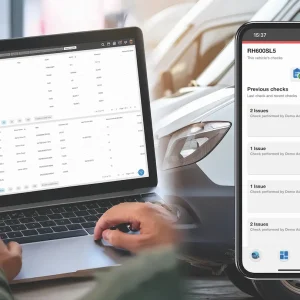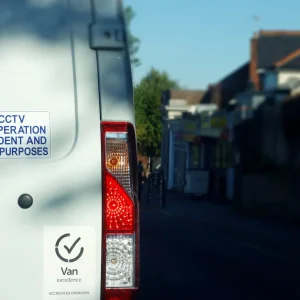
Is your van fit to be on the highway? OK, it might have squeaked through its MOT test a few months and several thousand miles ago, but that is no guarantee that it is in tip-top condition today.
“Many vehicles on our roads are simply not roadworthy,” says Mark Cartwright, head of commercial vehicle incident prevention at National Highways, which manages England’s motorways and major A roads. “Up to a third of all vans fail their MOT on first inspection, mainly because of faults involving the lights, tyres, suspension or brakes.
“If they’re not being checked just before a van is submitted for its MOT, then you have to wonder if they are ever checked at all,” he adds.
It was these and other safety related concerns that prompted National Highways to introduce its Driving for Better Business programme. Designed to help employers in both the public and private sector reduce work-related road risk, it is free to access (www.drivingforbetterbusiness.com) and embraces a host of online tools developed with safety in mind.
The programme’s vehicle roadworthiness kit for van drivers is a prime example.
It advises them to submit their vehicles to a daily walkaround check, ensuring for example that the lights, windscreen washers, wipers and horn all work, that the brakes are functioning and that there is no excessive play in the steering. In addition, they should check that the tyres are free of cuts and other defects, at the correct pressure and have sufficient tread on them.
The AA points out that tyres fitted to light commercials grossing up to 3.5t should have a tread depth of at least 1.6mm throughout a continuous band covering the centre three-quarters of the tread and around the entire circumference of the tyre.
Drivers should record their walkaround check findings on paper or – preferably – on a smartphone app. Any faults should be reported to the vehicle’s owner, accompanied by photographs if necessary if a smartphone is being used. If they are serious, then the van should not be driven on the public highway before they are fixed.
“The Highway Code states that drivers must ensure their vehicle complies with the full requirements of the Road Vehicles (Construction and Use) Regulations and Road Vehicles Lighting Regulations,” National Highways observes.
Severe risks
Taking a faulty van out on a delivery run anyway and keeping your fingers crossed is, to say the least of it, unwise. Aside from the fact that bald tyres and defective brakes add up to a potentially catastrophic accident waiting to happen, the Driver and Vehicle Standards Agency (DVSA) carries out regular roadside checks of
light commercials as well as heavy trucks – and two-thirds of the vans its enforcement officers pull over have major mechanical defects.
The officers can issue a prohibition notice which will prevent a van from continuing on its journey if a fault is serious enough. National Highways points out the penalties for driving an unroadworthy vehicle are severe, with fines of up to £2,500, the likelihood of three driving licence penalty points and the possibility of a driving ban for the individual at the wheel if a dangerous fault is discovered.
Employers need not assume that they will escape scot-free.
National Highways points out that health and safety legislation obliges them to take proactive steps to manage road risk. Allowing employees to drive company vans with bald tyres and dodgy brakes breaches this requirement, and could leave them open to legal proceedings if an accident occurs because a vehicle is riddled with defects.
In addition to addressing roadworthiness, the Driving for Better Business guide covers topics such as preparing for winter weather, drug and drink driving, driver fatigue, driver distraction, safe loading and mental health and driver wellbeing. Each one includes posters that can be printed out and pinned on noticeboards and short reminders that can be fed to in-cab messaging systems.
“The guides can be downloaded and used as many times as is necessary,” Cartwright says.
Focus on drivers
Even the best-maintained van can be a collision waiting to happen in the hands of a driver whose skills at the wheel are not all that they should be. Leading independent road safety charity IAM RoadSmart runs coaching sessions which can help identify areas that could benefit from improvement; and those improvements could lead to benefits over and above a welcome reduction in bumps and bangs.
A less aggressive driving style featuring smooth acceleration, steady, legal speeds and a reduction in sudden, sharp braking is always going to be a safer driving style; and fuel bills will fall too.
IAM RoadSmart says that what it describes as ‘eco-driving’ can lead to fuel and tyre wear savings totalling over £500 annually per van, with CO2 emissions down by up to 14%. As evidence, it cites data collected from 4,500 participants in its Driving for Work training courses.
“Driving aggressively is one of the most pointless things someone can do,” says director of policy and standards, Nicholas Lyes. “It’s dangerous, stresses out the person doing it, angers other road users and will not get you where you want to be any more quickly.
“Not only are you risking a crash for absolutely no benefit, you are also burning money and creating more emissions.”
Drivers and their employers are increasingly having to familiarise themselves with important changes in vehicle technology.
RED Corporate Driver Training has been running courses for individuals who are having to get to grips with electric light commercials. Because of the weight of their battery packs, they are invariably heavier than their diesel-powered counterparts, and that has implications for their handling and braking.
They also generate a surprising amount of power and torque, and all that torque is instantly available.
RED points out that because electric vans are so quiet, pedestrians may not hear them approaching and step out in front of them without realising the danger they are in. The vehicles concerned are likely to emit a warning sound at low speeds, but there is always the danger that it will be ignored; especially if pedestrians are paying more attention to what’s on the screen of their smartphones than to their surroundings as they cross the road.
Drivers need to anticipate this sort of careless conduct and be ready to respond accordingly.
ADAS explanation
RED is also ensuring that drivers become familiar with ADAS – Advanced Driver Assistance Systems. They are of course not unique to battery-electric models, and can take drivers who are not used to them unawares.
The Cruise Assist Plus system available on MAN’s latest TGE van, which What Van? recently sampled on a test track in Germany, is a case in point.
We approached the rear of a mocked-up hatchback at a speed of around 20mph, pretended to be distracted and made no attempt to slow down. As we got perilously close to the hatchback’s back bumper, Cruise Assist Plus intervened and the van came to a sudden, complete stop, tightening everybody’s seatbelts and clamping the driver and passengers firmly to their seats.
We were expecting this to happen, so we weren’t in any way alarmed. However, we’d have been mightily disconcerted if we’d been unaware that our TGE had this (undoubtedly laudable) feature.
Too many light commercial drivers thunder along at speeds way in excess of 20mph when they shouldn’t, RED contends.
Last year, it cited figures compiled by the Department for Transport (DfT) which showed that 45% of van drivers were speeding in free-flowing traffic in 30mph zones, with 5% reaching speeds in excess of 40mph. On motorways, 47% of them broke the 70mph limit, with 10% travelling at over 80mph.
Clearly, driver training needs to emphasise the importance of obeying the speed limit, but the DfT’s statistics also indicate some confusion among drivers about the limits that apply to light commercials on unrestricted roads. Recipient of the 2025 What Van? awards Highly Commended Risk Management accolade, RED has come up with an interactive e-learner video which explains what they are.
Under the ‘SafetyFirst’ banner, RED has developed a series of video-based e-learning modules covering topics such as fatigue, speed awareness and motorway, urban and rural driving. The fleet manager’s dashboard can identify which drivers have completed which modules; and those who have failed to complete any at all.
Driver monitoring
It is worth noting that many telematics systems incorporate driver monitoring packages which identify instances of speeding and unnecessarily harsh braking and acceleration; failings that can be addressed with targeted training. Such packages can include driver-facing cameras which can spot individuals who are smoking, eating or texting while at the wheel, are clearly distracted or appear to be falling asleep.
An individual may be unfit to drive to begin with as a consequence of poor eyesight, an undisclosed medical condition, or alcohol or drug abuse.
Fleet Operations, the overall winner of the 2025 What Van? Risk Management Award, has introduced the MOVE driver app which, among other things, enables drivers to carry out their walk-around checks and requires them to confirm their own fitness to take a van out on the highway. They can be asked to agree to undergo a random alcohol or drug test if so requested.
Drivers need to know how to respond if they face a serious on-highway hazard. Practical training in this area can be problematic however because it can involve exposing employees to risk; and that can be bad news if things are going badly wrong during a training exercise.
Recognising the difficulty, FORS, the Fleet Operator Recognition Scheme, has launched a virtual reality driver training tool. It enables users to experience all sorts of perils on rural and urban roads and motorways without putting them in harm’s way.
“They are placed in high-risk situations, but they don’t face any actual danger,” says FORS concession director Geraint Davies.
Pulling together all the information you need to ensure your drivers and vehicles are compliant can be problematic.
Working in partnership with the Driving for Better Business scheme, Convey Technology offers a range of cloud-based fleet management software modules. They allow its clients to do everything from recording and managing driver training and keeping tabs on vehicle maintenance to carrying out driver licence checks.
It’s not unknown for individuals to receive a drink driving ban, yet somehow forget to inform their employer and carry on driving anyway.





